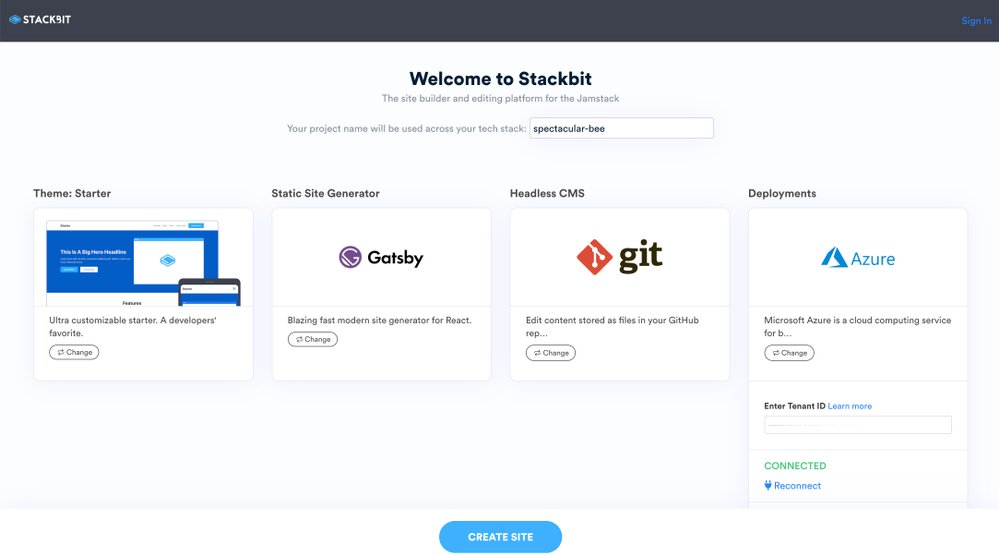
by Contributed | Feb 19, 2021 | Technology
This article is contributed. See the original author and article here.
Stackbit is the first open, complete platform for the Jamstack. You can start from a theme or your existing site, customize it in the browser with Stackbit Studio, and deploy it in minutes. Stackbit allows you to generate Jamstack websites with a combination of tools. You can choose a static site generator like Gatsby, Next.js, or Hugo, and edit your site directly from Stackbit Studio.
Azure Static Web Apps is a service for running globally-distributed full stack web applications. It supports custom domains, free SSL, serverless functions, and more.
We’re excited to share that Stackbit now supports deploying to Azure Static Web Apps! With this integration, you can seamlessly deploy your site using your Microsoft Azure account.
Create a free Jamstack site in minutes
 Select a theme, static site generator, and connect to your Azure account
Select a theme, static site generator, and connect to your Azure account
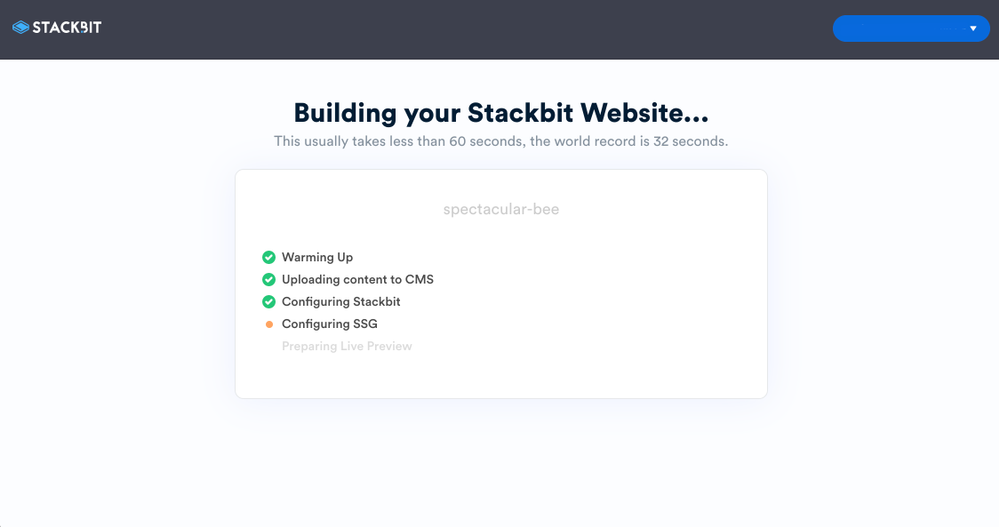 Your project is ready in a few seconds
Your project is ready in a few seconds
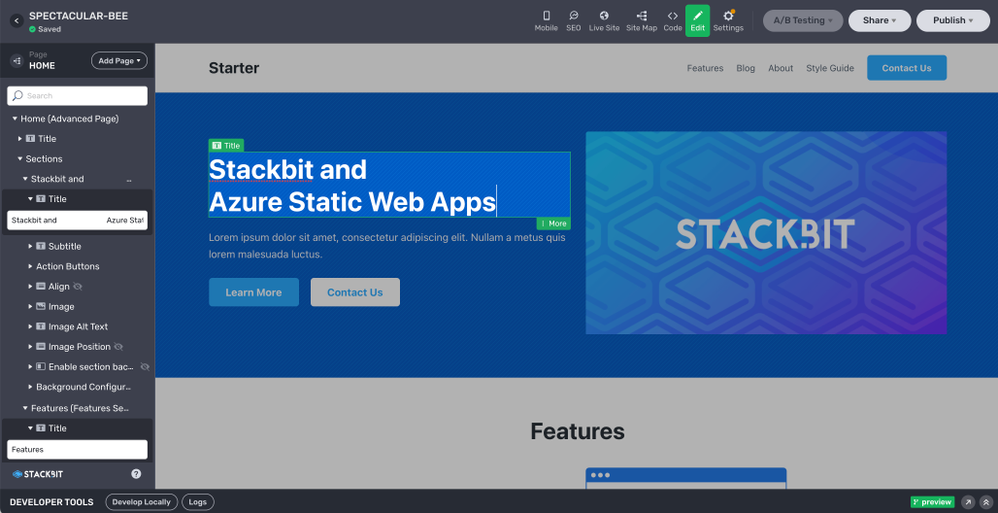 Design your site in the in-browser Stackbit Studio
Design your site in the in-browser Stackbit Studio
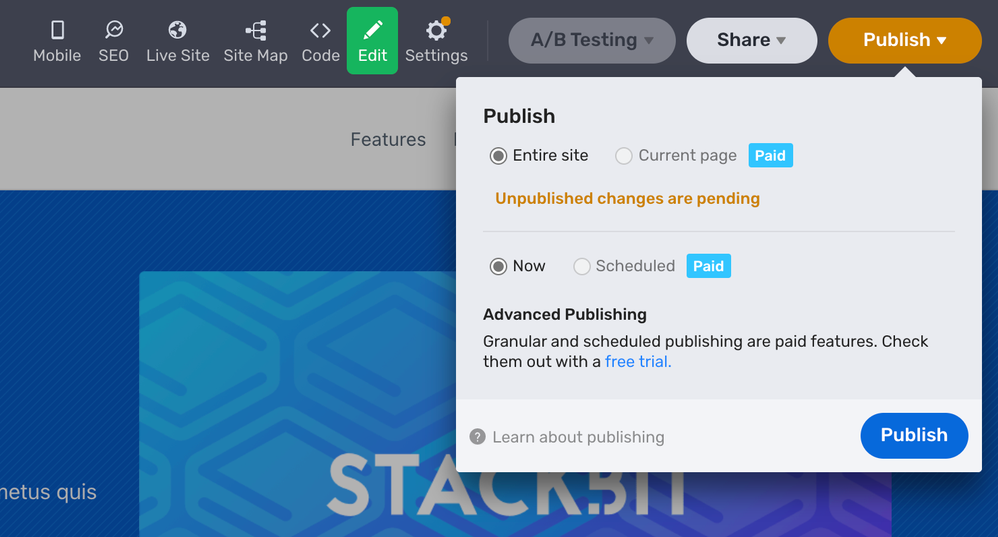 Publish to Azure Static Web Apps
Publish to Azure Static Web Apps
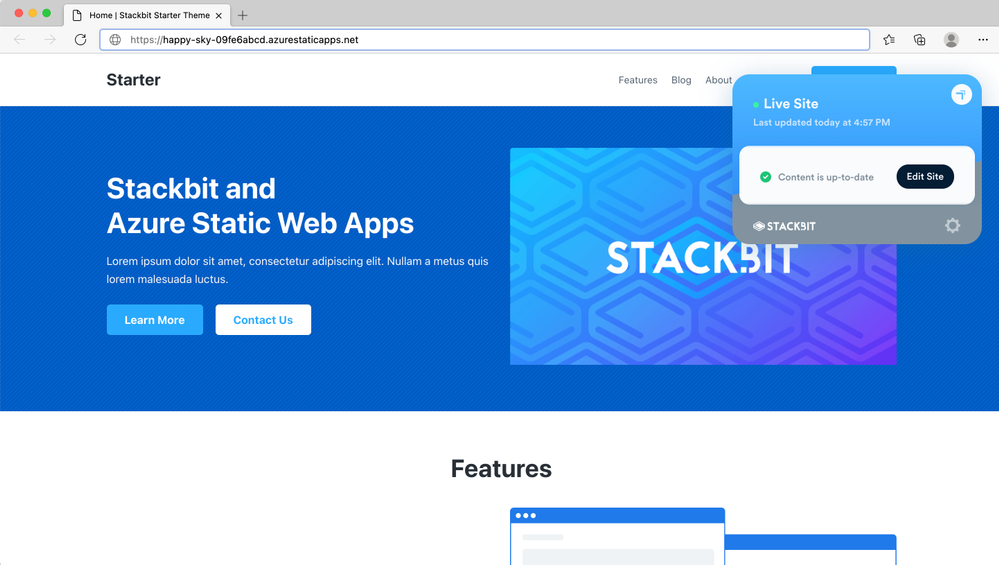 Your site is live on Azure Static Web Apps!
Your site is live on Azure Static Web Apps!
Try Stackbit and Azure Static Web Apps
To learn more and get started today, check out Deploying Your Jamstack Site To Azure in the Stackbit documentation.
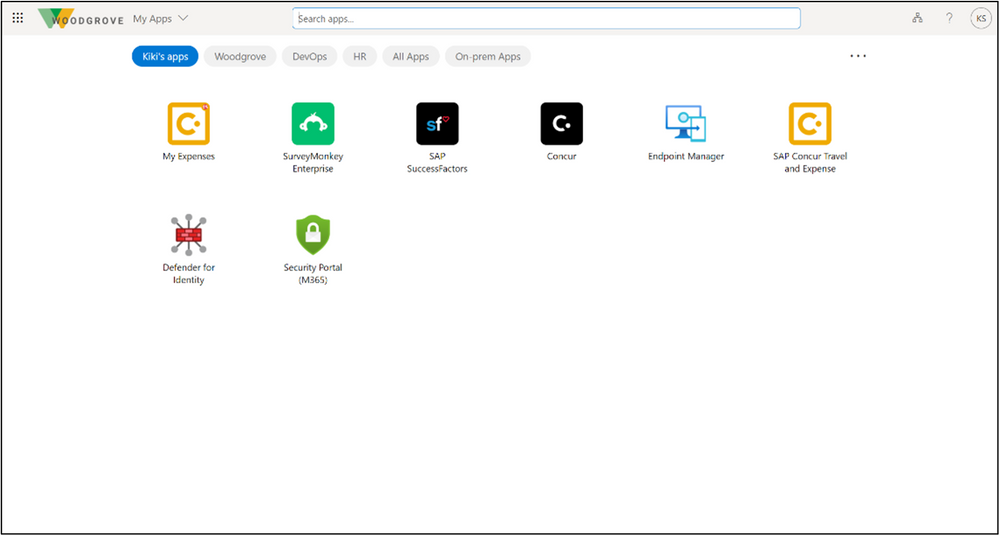
by Contributed | Feb 19, 2021 | Technology
This article is contributed. See the original author and article here.
Howdy folks,
I’m excited to share the latest Active Azure Directory news, including feature updates, support deprecation, and new capabilities that will streamline administrator, developer, and user experiences. These updates show our commitment to simplifying identity and access management, while also enhancing the customization and controls you need.
Intuitive user experiences
- GA of user-based collections in Azure AD My Apps –With the general availability of user-based collections in Azure AD My Apps, users can now create and manage their own personalized app collections while freeing IT resources and time for other tasks.
With My Apps collections, you can create tabs organized by app function, role, or other categories that make it easier to discover and access apps. These collections can also be surfaced in the Office portal, if organizations want to combine broad app launch within their Office productivity hub. Since the public preview, this will now be available by default in all tenants and no special URL is required.

User-based collections in Azure AD My Apps, now generally available.
Security
- GA of new risk detections in Azure AD Identity Protection – Three new risk detections—the Microsoft Cloud App Security (MCAS) New Country, Activity from Anonymous IP Address, and Suspicious Inbox Forwarding Rules—are now generally available. These signals are integrated from MCAS to influence both sign-in and user risk in Identity Protection. Customers currently using MCAS don’t need to take any additional steps for these three new risk detections to flow into Identity Protection. They can be found in the risky sign-ins blade, risk detections blade, and the risk history tab of the risky users report.
This integration expands the surface area of our detections with insight into intrasession activity, improves our signal quality, and delivers on our One Microsoft value by leveraging signals across the Microsoft ecosystem. There is also a link back to the MCAS UI in the risk details so that admins can investigate further if necessary. You can now see all the MCAS detections that Identity Protection has consumed by filtering on “Microsoft Cloud App Security” as the source in either the risky sign-ins or risk detections blades.
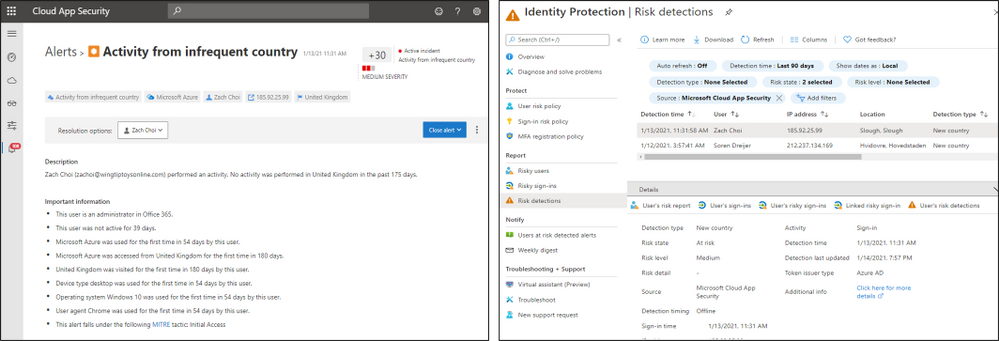
Alerts in MCAS automatically flow into Azure AD Identity Protection.
Reminders
- Support for unmanaged Azure Active Directory accounts ending in October 2021– We previously shared that Microsoft would no longer support the redemption of invitations using unmanaged Azure Active Directory accounts starting March 31, 2021. Based on your feedback, we are delaying the transition from March 31, 2021 to October 31, 2021. Starting October 31, 2021, Microsoft will no longer support the redemption of invitations by creating unmanaged Azure AD accounts and tenants for B2B collaboration scenarios. To prepare for this, you are encouraged to opt into email one-time passcode authentication, which was made generally available earlier this year.
- Deprecation of Azure AD Connect sync old versions – We recently announced that we will no longer support old versions of Azure AD Connect sync (versions published before May 5, 2018 – 1.1.751.0 and older) to ensure customers are using versions with additional security and performance benefits. To minimize service disruption, upgrade to a newer version of Azure AD Connect sync before February 29, 2024. For help with your update, refer to our migration guide, reach out to our community experts, or open up a technical support request.
As always, we’d love to hear your feedback or suggestions in the comments or on Twitter (@AzureAD). I also invite you to join me and other Microsoft leaders at Microsoft Ignite, March 2-4. Registration is free and includes access to sessions covering important topics in our industry, such as the Zero Trust security model, decentralized identities, going passwordless, and more.
Alex Simons (@Alex_A_Simons)
Corporate VP of Program Management
Microsoft Identity Division
Learn more about Microsoft identity:
by Contributed | Feb 19, 2021 | Technology
This article is contributed. See the original author and article here.
The world of certifications, exams, and assessments is a complicated one. Added to that, many of the words that we use in the certification industry have very specific meanings that may not align to their common, everyday usage. I know this can be confusing and challenging to keep everything straight if you’re not immersed in this every day, and even when you are—see, for example, my team, even makes mistakes and I often have to correct them. So, I thought it would be helpful to define and explain some of the most misused or misunderstood terms. What makes something a certification vs. a certificate?
A certification is an independent evaluation of knowledge and/or skills. This means that it doesn’t matter how you got the skills, only that you have them. This is important because you can earn a certification without taking training or learning. If you already have the knowledge, skills, and abilities being assessed, you don’t need the training, and we shouldn’t require it to earn a certification. From a psychometric perspective, the hallmarks of a quality certification are:
- We have confirmed that you are who you say you are (identity verification),
- We have ensured that the person who submitted the work is the person who did the work (proctoring),
- Passing the exam does not require taking a prescribed learning path, and most important from my perspective,
- We have ensured that the evaluation process is psychometrically sound.
By psychometrically sound, I mean that the evaluation is:
- Valid (measuring what it’s supposed to be measuring and not something that is irrelevant (like test taking ability) to the content domain),
- Reliable (repeated measurements yield the same results all things being equal (if you don’t change your test preparation strategies, odds are you’ll get the same score each time you take the exam), and
- Fair (all test takers are treated the same or have the same opportunity to demonstrate their knowledge and skills).
In addition, as an organization employing certification holders, you should also consider[1]:
- Is the certification program from a significant provider of your IT infrastructure?
- Is the certification program aligned to roles that are relevant to your organization’s current and future requirements?
- Are the skills represented by the certification program evolving with the technology?
A certificate is the artifact that you receive after earning a certification. To complicate things a bit, in the world of exams, assessments, and tests, you can also earn an assessment-based certificate. These are based on training; in other words, you will most likely need to take the training in order to pass the assessment as many of the questions will be specific to that learning opportunity.
We distinguish an exam, which is tied to a certification, from an assessment, which is linked to training, for this very reason. If you take an exam, it’s an independent evaluation of skills; if you take an assessment, it often is not. Because we are providing a customized learning path specific to the new skills as part of our certification renewal process, I fought hard that the evaluation at the end be called an “assessment” rather than an “exam.” Although you won’t find the exact answer to the questions in the learning materials, we have designed the learning materials in a way that provides a very targeted means to prepare for the assessment. While you don’t need to complete the learning materials to take the renewal assessment, the modules included are focused on what is covered by the assessment and doing so will certainly increase the odds that you pass it.
Confused by these distinctions? You’re not the only one. Check out these great resources that do an excellent job of differentiating the different types of credentials in the marketplace:
Differing Types of Workplace Credentials – YouTube
Accreditation Type Chart One-Pager (workcred.org)
Certification-related
Now, that you have a better understanding of what makes something a certification, let’s look at a few certification-related terms and how Microsoft defines them.
- Active certification: A certification that you have earned that has not expired. This is in contrast to an ‘inactive certification,’ which is one that has expired or no longer has value in the industry.
- Certification dashboard: Your “one stop shop” for everything related to your active and past certifications and certification exams. You will also find links to help you register for exams as well as view or download badges, certificates, and transcripts of your certification accomplishments.
- Certification history: Two years after a certification retires, it will move to the “Certification History” section of your transcript. Any certifications that have expired will also move to this section of your transcript.
- Certification renewal (renew): If your certification is still active, you can renew it and thus, extend the expiration date. If you do not renew your certification, it will expire and become inactive. Once it expires, you will need to re-earn the certification by completing the certification requirements as if you were starting over.
- Certification renewal assessment: The set of items that you must complete and pass to demonstrate your ongoing competence to extend the expiration date of your certification.
- Certification expiration date: The date after which your certification will no longer be active, meaning that you have not revalidated your ongoing competency and skills in the job role or specialty. If your certification expires, you must re-earn it.
- Fundamentals: Earning a fundamentals certification validates your foundational understanding with mixed concepts and applied learning of Microsoft technologies.
- Recertification: Re-earning the certification as if you are starting from scratch.
- Note that Microsoft’s use of “recertification” is a bit different from many other certification programs because our candidates find it confusing to differentiate renewing a certification from having it expire and having to re-earn it. If you renew it, you have not let it expire; if you recertify, you have and must re-earn it.
- Role-based: Our certifications are aligned with industry leading cloud-based job roles. Earning one of our role-based certifications demonstrates that you have the key knowledge, skills, and abilities to perform in that job role using Microsoft platforms and technologies.
- Retired certification: The certification can no longer be earned. This typically follows the retirement of the associated exams.
- Specialty: Earning a specialty certification validates deep technical skills and ability managing industry solutions, including third party solutions, on or with Microsoft platforms and technologies.
Exam-related
Remember, to earn a certification, you must pass one or more exams. Here are some common exam-related words and how Microsoft defines them:
- Item: A question on an exam; these can take many forms from multiple choice to drag and drop to active screen to labs (we don’t call them ‘questions’ because they may not always take the form of question).
- Exam: A set of items that you must answer in a specified period of time in a secure environment after proving your identity. You must pass one or more exams to earn a certification. Exams do NOT expire, but they do, however, retire. Retired exams can only be used for one year after they retire to meet certification requirements.
- Beta exam: The first release of an exam that is designed to get psychometric information on each of the items, so we truly understand how an item works in an exam-like situation. No matter how good an item is on paper, there are always issues that reveal themselves during the beta process that no one could have predicted otherwise. To learn more about beta exams, visit: About Microsoft Certification exams | Microsoft Docs.
- JTA (Job task analysis): The detailed process of outlining all knowledge, skills, and abilities that are needed to be successful in a given job role, specialty, or content area. This can take on many different names depending on a certification program’s goals (e.g., competency analysis, practice analysis, task analysis, etc.), and although the output will be different, the process of how you get to that end point is fundamentally the same… so this process can be (and is used) even if the certification, exam, or assessment is not strictly a job role.
- Live exam: The version of the exam that results in near immediate scores when someone takes it. This version has incorporated all of the beta feedback and remains available until the exam retires.
- OD (Objective domain): The list of knowledge domains, skills, or tasks that are covered by the exam. This is a subset of what was identified in the JTA.
- Skills outline document: Based on the OD, it defines the target audience and lists the knowledge, skills, or abilities that will be assessed on the exam.
- Retired exam: The exam can no longer be taken, but if the exam is one of several certification requirements, it can be used to fulfill the certification requirements for up to one year after it retires. For example, MB-200 is used as one requirement in several functional consultant job role certifications in Dynamics 365. That exam is being replaced by PL-200. However, if you have passed MB-200, you can use this exam to meet the requirements for those functional consultant job role certifications for up to one year after it retires… so if you have passed MB-200, be sure to pass the other exam in your certification path within that year so you don’t have to pass PL-200 to meet the requirement. This is confusing, so I’m hoping the two tables below will help clarify how this works:
On or before December 31, 2020:
|
On or before December 31, 2021:
|
Result:
|
Passed MB-200
|
Pass MB-210, 220, 230, or 240
|
Earn the associated functional consultant job role certification
|
On or before December 31, 2020:
|
On or after January 1, 2022:
|
Result
|
Passed MB-200
|
Pass MB-210, 220, 230, or 240
|
You will need to pass PL-200 to earn the associated functional consultant job role certification
|
Learning/Training-related
- Continuous learning: What you should be doing every day! With the pace of change in technology and the daily growth of new information, to remain successful, you must continue to learn. Invest in yourself by completing a self-paced learning path on Microsoft Learn or taking a course through one of our Learning Partners.
- Instructor-led training (ILT): In-depth structured training courses facilitated by an instructor. They include hands-on elements, are based on Microsoft Official Courses, and provide more personalized attention and support in the areas where you need it most through your interactions with the instructor. Most ILT courses are multiple days.
- Learner: You!
- Learning Partners: Training organizations around the globe that have met minimum program requirements to be able to publicly teach Microsoft-developed training content via Microsoft Certified Trainers (MCTs). More information on Learning Partners and the markets they serve can be found here.
- Learning path: Learning paths on Microsoft Learn are collections of learning modules that are organized around specific roles (like developer, architect, or system admin) or technologies (e.g., Azure Web Apps, Power BI). When you finish a learning path, you’ve gained a new understanding of different aspects of the technology or role you’re studying. You also earn a trophy!
- MCTs (Microsoft Certified Trainers): Our premier technical and instructional experts in Microsoft technologies who lead ILT courses provided through Learning Partners; some are free-lance while others are employed by Learning Partners. Because they have completed rigorous training and have met stringent technical certification requirements, they are the only instructors qualified to deliver Microsoft Official Courses. Learn more about the MCT program.
- Module: Modules on Microsoft Learn are the building blocks of the learning experience. Think of a module as a course that contains a collection of related units, such as videos, labs, and articles. When you finish a module, you’ve gained a new skill that relates to your role and target technology. You also get a badge!
- Microsoft Learn: Microsoft Learn is the place to start and customize your learning journey with up-to-date content developed by experts and a variety of resources. Choose from free self-paced learning, instructor-led training, and certifications, covering existing and newly released Microsoft technologies. Learn more in this video.
- Sandbox: The Microsoft Learn sandbox is a free environment you can use to explore Azure through Microsoft Learn content. It‘s a temporary subscription that’s added to your account which allows you to create resources for the duration of a module. Microsoft Learn automatically cleans up the temporary resources for you after you’ve completed the module.
- Training: Designed to help those who want to acquire a new skill, chase a new career path, and stay up to date on the latest technological advances.
Are there other terms that you don’t understand or are confused about? Let me know. I’m happy to clear up what I can.
[1] Source: IDC white paper, sponsored by Microsoft, Benefits of Role-Based Certifications, June 2020, #US46572820
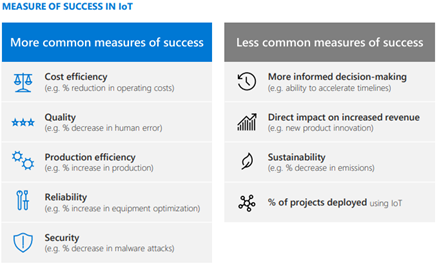
by Contributed | Feb 19, 2021 | Technology
This article is contributed. See the original author and article here.
The Internet of Things (IoT) has a huge opportunity in front of it when it comes to sustainability. We recently launched a new Azure IoT for Sustainability page. About a year and a half ago, I started to have a conversation with our partners about how sensors are at the heart of all the solutions that could be labeled “sustainability solutions.” It occurred to me that we, the IoT solution building community, have been talking about sustainability for a long time without knowing it. Every solution I look at has a return on investment (ROI) that is tangible to existing and traditional business goals, and an ROI that is intangible to the immediate solution unless you see it through a lens of sustainability.
It is ironic that I am about to write a blog post about sustainability solutions by talking about oil. Not fossil based fuel type of “oil,” I’m talking about data. To understand our opportunity today for reaching our environmental sustainability goals with data, I need to take you back in time.
History :: The rise of Big Data 2.0
A few years back the quote du jour was “Data is the new oil.” It was circa 2006 where Big Data 1.0 and cloud computing were on the rise when Clive Humby said this. The crush of data came from us, literally. The humans clicking buttons on web pages. When the “rise of the apps” began, data solution architects had a real struggle learning to deal with all that data let alone to gain insights with it and technologies were invented to fix this problem. Examples of those innovations are real time analytics, recommendation engines powered by graph databases, and new NoSQL data platforms to handle that amount of data.
Now we are in a new age of Big Data that is driven by the Internet of Things (IoT): Big Data 2.0. Ten years ago, I don’t think I had anything “smart” in my house telling me when to do things with sounds besides my cat Thomas. Looking around, now I have a fridge, a dishwasher, a laundry room, and several other devices that are constantly talking to the cloud.
The Thought Exercise :: Tangible ROI vs. Intangible ROI
For the sake of this example, imagine a post covid-19 office “smart” building. A room has a sensor that can sense occupancy and turn the lights on and off. Every time the sensor detects movement in the room, it sends a message to the system saying, “activity in room detected”, and at the same time a message is sent to the light being told to turn on.
 IoT Signals Report 2020: Measures of Success in IoTFigure A. [source: IoT Signals – Industrial IoT Trends and Solutions | Microsoft Azure]
IoT Signals Report 2020: Measures of Success in IoTFigure A. [source: IoT Signals – Industrial IoT Trends and Solutions | Microsoft Azure]
The “Tangible Return on Investment (ROI)” for a business, in my mind, are those listed under “More common measures of success” in Figure A. The “Intangible ROI” is the ROI that is not measurable by our standard definition of ROI but affects environmental sustainability goals, as seen in Figure A as “less common measure of success.” In the above example, the installation of the smart lights is reducing the electricity bill. Before the new lights, the electricity bill was $X, and after the installation of said smart lights it is now $Y. On our reporting dashboard we will see the $X – $Y month over month savings.
Now, we can get creative and add a new data source, the meeting scheduling engine. We combine the on/off data of the lights and the electricity bill, and then bring in the meeting data. How many meetings do we have scheduled in rooms that the lights never go on? If we can identify these ‘ghost meetings’, can we get more efficient with office space and potentially move to a smaller physical footprint and thereby pay less rent? This is another Tangible ROI to the bottom line by being efficient with our rent in addition to our new lowered electricity bill. These are probably enough ROI for any business owner to say this solution is worth the price to install it. Especially if one had 100 buildings, and we are talking about a savings in the millions.
So, here is the thought exercise: What is the Intangible ROI in this example?
For this exercise, I will use an analogy to Maslow’s hierarchy of needs in that the base ROI is “my bill is lower, and I save money.” That is a basic need of business to raise revenue by keeping costs down. But what has also happened in doing that is the use of energy has gone down. This is now speaking to other goals the business may have or rolls up to sustainability goals for a city or country.
This is ROI that is at the self-actualization level in my analogy. The business is contributing to an ROI they may be tracking for sustainability, but any ROI for sustainability is a global contribution that benefits all of us.
Growth Mindset quickly shows us that Intangible ROI is a misnomer
At this point, I would suspect you may argue that intangible ROI is in fact quite tangible. You would be right. Like I said in the beginning, it has been hiding in plain sight the whole time.
The minute you start to see solutions this way you can’t go back. A retail solution that is saving a business money by using sensors to monitor a restaurant kitchen to reduce ingredient spoilage is reducing food waste. Building an asset tracking solution that is monitoring delivery trucks to save money on gas? That solution is also reducing use of fossil fuels and lowering emissions. Predictive maintenance on pipes to prevent leakage? If we are talking about water pipelines, we are reducing water waste. If we are talking midstream oil pipelines, we are helping to prevent potential damage to ecosystems.
For those of you in the IoT space, I invite you to look at your portfolio of solutions you have worked on and see if you can find the sustainability ROI in them. As you embark on a new project, I invite you to become an advocate for the sustainability ROI bringing this conversation into architectural design sessions and business model workshops.
Increasing Tech Intensity whist lowering carbon intensity
Sustainability isn’t a vertical or a horizontal. It’s a diagonal. Sustainability touches every aspect of our industries and our lives. It is the one area of innovation that if we don’t start to weave it into all our solutions, it will impact us in ways we are only beginning to understand.
We can change what we can measure. We can measure what we record. We can record what data can capture. IoT is the foundation for data capture that will enable us to achieve our environmental goals.
No matter where you are on your sustainability journey, Microsoft is creating tools and solutions to support you. We are so excited to release the Azure IoT for Sustainability website and invite you to visit to begin your sustainability journey with IoT.
Together we will fix this. We must.
 Our Earth
Our Earth
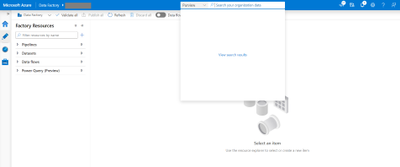
by Contributed | Feb 19, 2021 | Technology
This article is contributed. See the original author and article here.
This is the second blog in the “ADF/Purview integration” series. And today we are going to discuss integrating Purview assets into ADF to boost the ETL process.
Discovering and understanding data sources and their use is a big challenge for data engineers in the organization and has been an organic process based on communal knowledge. Unless they know the location of a data source and understand their business value, it’s very difficult to discover these data sources and build efficient data workflows to orchestrate data movement and transform data at scale.
Azure Purview is a unified data governance service that helps you manage and govern your on-premises, multi-cloud, and software-as-a-service (SaaS) data. The Purview Data Map can capture metadata about enterprise data present in analytics and operation systems on-premises and clouds.
With the integration of Azure Purview, data engineers can quickly & easily find relevant data using a search experience in Data Factory portal, know the data and understand its business value, then bring them into Data Factory as linked services or datasets.
Data discovery: search datasets
As a data engineer, the first step in establishing a data workflow is to find the required data source and understand the meaning and business value of the data. Therefore, a place that can provide this information is very useful for data engineers, which can greatly shorten the time and process of searching for data.
To discover data registered and scanned by Azure Purview, data engineers can use the Search bar at the top center of Data Factory portal.

Actions that you can perform over datasets with Data Factory resources
Data engineers can directly create Linked Service, Dataset or Dataflow over the data they search using Azure Purview and build code-free ETL workflows for orchestrating data movement and transforming.
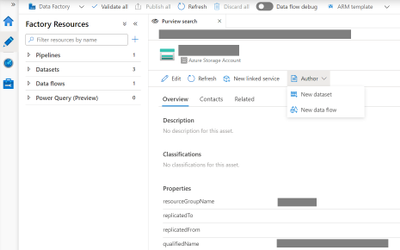
Next steps
Select a theme, static site generator, and connect to your Azure account
Your project is ready in a few seconds
Design your site in the in-browser Stackbit Studio
Publish to Azure Static Web Apps
Your site is live on Azure Static Web Apps!


Recent Comments